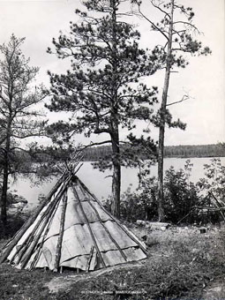Ojibwe

In his diary, Du Vernet meets many Ojibwe people, seeing their culture and hearing their language first hand. The Ojibwe, also known as Anishinaabeg, are Indigenous peoples whose traditional territories surround and radiate outward from the Great Lakes, on both sides of what is now the Canada-US border.
The Ojibwe People
According to oral tradition, the Ojibwe were originally from the St. Lawrence’s Atlantic mouth before beginning a long migration westward to the Great Lakes region in the seventeenth century. From there, the Ojibwe continued to move further west, some migrating to what is now southwestern Ontario, Wisconsin, and Minnesota, while others went north, to northwestern Ontario and Manitoba. These more northerly Ojibwe are sometimes called Saulteaux and are located along the Rainy Lake and River and the Lake of the Woods region that Du Vernet traveled.
Language
The Ojibwe language, Anishinaabemowin, is a branch of the Algonquian language family. It has many regional dialects, which when grouped together make Ojibwe the second most-spoken Indigenous language in Canada today. There is no single writing system that covers all of Ojibwe’s dialects, but in Du Vernet’s time missionaries like John Sanders translated several important Christian works into the language. Jeremiah Johnston could speak Ojibwe and conducted Christian services in the Ojibwe tongue.
Culture and General History
Traditionally, the Ojibwe people were hunters, fishers, and gatherers. They lived in dome-shaped birch bark homes called wigwams, wore clothing fashioned from animal furs and skins, and travelled by birch bark canoe in the warmer seasons and snowshoes in winter. Ojibwe society was structured around bands, with each band having its own chief, hunting grounds, and internal social structure.
Many Ojibwe continue to have a strong spiritual connection to nature, believing the natural world to be made up of many spirits, both good and evil. The greatest power in the Ojibwe spiritual world is the Kitchi Manitou, or The Great Spirit. According to Ojibwe stories, Kitchi Manitou gave them their spiritual ways when the spirit came down through the star constellation Paagonekizhig, the Hole in the Sky. The Ojibwe medicine society, known as the Midewiwin, centres around honouring and communicating with the Kitchi Manitou and other spirits. Du Vernet observed some of these religious ceremonies, referring in his diary to the medicine tent, medicine men, and Ojibwe burial practices.
Following European contact, Ojibwe life was dramatically altered. By the mid-seventeenth century, the Ojibwe were an integral part of the fur trade, linking European traders with Indigenous communities further west. Yet with the fur trade came more settlers and greater disruption to traditional Ojibwe lifestyle. As with most Indigenous peoples, in the nineteenth century the Ojibwe people were moved onto reserves.
The Ojibwe in Northwestern Ontario
By the seventeenth century, the Ojibwe were present in what is now northwestern Ontario, along with other Indigenous groups which contended with each other for territory. By the late eighteenth century, the Ojibwe lived across northwestern Ontario.
In 1873, Ojibwe chiefs signed Treaty 3 or the Manidoo Mazina’igan (“Spirit Paper” or “Sacred Document”), an agreement with the Crown about Ojibwe territory along the Rainy River and Lake and near the Lake of the Woods. The Ojibwe understood the treaty as a land sharing agreement, emphasizing that they controlled and governed the land and waterways being negotiated. But the Canadian government did not honour the Ojibwe’s intent and instead used the treaty as a means to use Ojibwe territory for white settlement and large scale resource extraction. The government moved the Ojibwe onto Indian Reserves, limiting access to their traditional lands. The treaty established seven reserves along the Rainy River: Hungry Hall no. 1 and 2, Long Sault, Little Forks, and Manitou Rapids no. 1 and 2. In 1914 and 1915, the government forcibly closed all these reserves but Manitou Rapids, amalgamating the reserves into a single one under the pretense that the Ojibwe were unproductive farmers. The government then gave away Ojibwe land to settlers who would agree to farm it.
Today, many of the Ojibwe First Nations at Lake of the Woods, along the Rainy River, and Rainy Lake are in a long term process to regain their land or receive compensation for the government’s failure to fulfill its treaty obligations. In 2005, the Rainy River First Nation and the Canadian government agreed to a $71 million land claim settlement that identified land for future reserve creation and an external trust account (and investment portfolio) was developed for purposes of future economic development, education, health, cultural purposes, and community growth. Following a court order in February 2017, the governments of Ontario and Canada, together with the Rainy River First Nation, announced the return of some 6,000 hectares of reserve land.
Sources
Williams, David Arthurs. “The Long Sault Site: Cultural Dynamics in the Rainy River Valley of Northwestern Ontario.” Master of Arts Diss., University of Manitoba, 1982.
Waisberg, Leo G., and Tim E. Holzkamm. “‘A Tendency to Discourage Them from Cultivating’: Ojibwa Agriculture and Indian Affairs Administration in Northwestern Ontario.” Ethnohistory 40, no. 2 (1993): 175-211. doi:10.2307/482201.